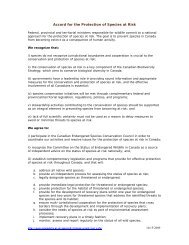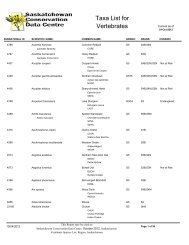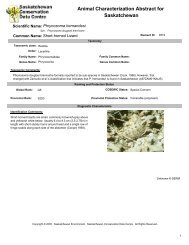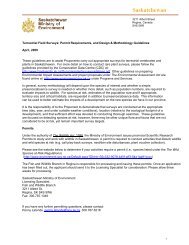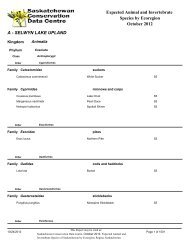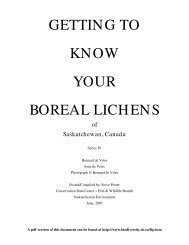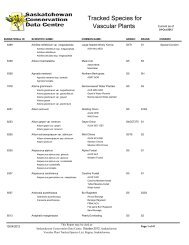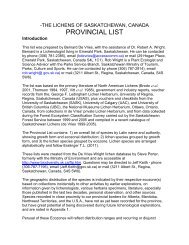Beaked Annual Skeleton-weed - Saskatchewan Conservation Data ...
Beaked Annual Skeleton-weed - Saskatchewan Conservation Data ...
Beaked Annual Skeleton-weed - Saskatchewan Conservation Data ...
You also want an ePaper? Increase the reach of your titles
YUMPU automatically turns print PDFs into web optimized ePapers that Google loves.
Scientific Name: Shinnersoseris rostrata<br />
Syn:<br />
Lygodesmia rostrata<br />
Common Name: <strong>Beaked</strong> <strong>Annual</strong> <strong>Skeleton</strong>-<strong>weed</strong><br />
Taxonomic class:<br />
Alt Com Name:<br />
Alt Com Name:<br />
Order:<br />
<strong>Annual</strong> <strong>Skeleton</strong><strong>weed</strong><br />
<strong>Skeleton</strong> <strong>weed</strong><br />
Dicotyledoneae<br />
Asterales<br />
Plant Characterization Abstract for<br />
<strong>Saskatchewan</strong><br />
Taxonomy<br />
Family Name: Asteraceae Family Common Name: Aster Family<br />
Genus Name: Shinnersoseris<br />
Genus Common Name:<br />
Taxonomic Comments:<br />
Element ID:<br />
Common Names: <strong>Beaked</strong> <strong>Annual</strong> <strong>Skeleton</strong>-<strong>weed</strong>; <strong>Annual</strong> <strong>Skeleton</strong><strong>weed</strong>; <strong>Skeleton</strong> Weed. Division: Spermatophyta<br />
Subdivision: Angiospermae Class: Dicotyledoneae Subclass: Metachlamydeae Order: Campanulatae Family: Asteraceae<br />
(Compositae); aster, composite or sunflower family. Subfamily: Liguliflorae Tribe: Cichorieae has many pappus bristles<br />
(not plumose), achenes columnar tapering to summit, not to base, involucre slenderly cylindric (from Gray's Manual, which<br />
includes this species in the genus Lygodesmia). Flora of the Great Plains includes S.r. [?/L.r.?] in the tribe Lactuceae.<br />
Genus: Shinnersoseris was described as a new genus by Tomb in 1973. Species: rostrata Synonymy: Lygodesmia juncea<br />
var. rostrata A. Gray; Lygodesmia rostrata A. Gray Derivation of names: [Lygodesmia from "Greek lygos, a pliant twig, and<br />
desme, a bundle, from the fascicled twiggy or rush-like stems"] Rostrata meaning beaked (rostrate, having a beak).<br />
(Fernald, p. 1558) Shinersoseris ? . ,Lygodesmia rostrata,<br />
Ranking and Protection Status<br />
Global Rank: G5?<br />
COSEWIC Status:<br />
Provincial Rank: S2<br />
Identification Comments:<br />
Provincial Protection Status:<br />
Diagnostic Characteristics<br />
Shinnersoseris rostrata is a slender tap-rooted, annual herb with erect<br />
stems that may be strict or with numerous branches, usually paired to<br />
give the plant a symmetrical shape, 1-10 dm (1-3') in height. It has been<br />
described as paniculately branched in the upper two-thirds. The stems<br />
are striate, and stiff, although not as rigid as those of L. juncea. Leaves<br />
elongated-linear, acuminate at the tip, entire, 3-nerved, the lower (5-8)<br />
opposite pairs to 15 cm (to 20 cm, or 7") in length and 6 mm (0.1 to 0.15")<br />
wide, gradually reduced upwards to near subulate, and becoming<br />
alternate. Leaves have been described as being 2-6 times the length of<br />
the internodes. The plants are glabrous and pale green with a milky sap<br />
white or cream in color.<br />
Heads are numerous, racemose along the branches on scaly, short, erect<br />
peduncles both terminal and axillary, to 12.5 mm (0.5") broad. Involucres<br />
are narrowly cylindric, (10)12 to 18(20) mm (0.5-0.7") high. The principal<br />
bracts (5)7-9 in number, linear, scarious-margined, equal, slightly united<br />
at the base, with several (one or two series of ) very short outer ones. The<br />
receptacle is flat and naked. Florets are 7-11 in number, purplish to pink<br />
at the tips, all ligulate and fertile. Great Plains Flora Association describes<br />
them as being lavender with yellow apices ... erect (i.e., not reflexed) at<br />
anthesis. This agrees with our material; as well the petals do not unfurl at<br />
the tips and the heads do not expand much beyond the vertical protrusion<br />
of the florets from the involucre. Anthers are dark purple, saggitate at the<br />
base. Style-branches are slender.<br />
Achenes narrowly fusiform or subcylindrical, narrowed or somewhat<br />
beaked at the summit, scabrate below the summit, (4)5-8 ribbed or<br />
-striate, 10 to 12.5 mm (0.4-0.5") long, longer than the whitish pappus<br />
which consists of copious somewhat unequal, simple capillary bristles<br />
somewhat connate at the base.<br />
N = 6, 2n=12.<br />
Lookalikes:<br />
Copyright © 2005. <strong>Saskatchewan</strong> Environment. <strong>Saskatchewan</strong> <strong>Conservation</strong> <strong>Data</strong> Centre. All Rights Reserved.<br />
11090<br />
Lamont, S. ©<br />
1
Shinnersoseris rostrata<br />
Scientific Name:<br />
Syn:<br />
Lygodesmia rostrata<br />
Common Name: <strong>Beaked</strong> <strong>Annual</strong> <strong>Skeleton</strong>-<strong>weed</strong><br />
Alt Com Name:<br />
Alt Com Name:<br />
<strong>Annual</strong> <strong>Skeleton</strong><strong>weed</strong><br />
<strong>Skeleton</strong> <strong>weed</strong><br />
Element ID:<br />
Lygodesmia juncea<br />
Shinnersoseris rostrata was originally included in the genus Lygodesmia, actually as a variety of L. juncea. After 11 years<br />
it was granted specific status as L. rostrata. Finally it has been moved into a genus of its own (Shinnersoseris). Although<br />
these two genera are superficially somewhat similar there are some distinct differences that separate them. Firstly, S.r. is<br />
an annual, whereas our only species of Lygodesmia, juncea (the type species originally described as Prenanthes juncea),<br />
is a perennial. Next S.r. has leaves which are opposite in their position on the stem, at least for the lower few pairs,<br />
whereas those of L.j. are always alternate. Another distinction, which the floras fail to emphasize, and which seems to<br />
hold true at least in all of our material is the fact that the florets, which have been termed ray florets, do not expand as do<br />
those of L.j. The ray florets of L.j. will always unfurl both in width and over the length so that the head shows a star-like<br />
expansion at full anthesis, with the ray curving up to or more than 90 degrees. At least in our material of S.r. however, the<br />
contiguous tepals remain coiled in a tube. The head does not expand much beyond the vertical extension of this petal<br />
tube, so that the "rays" do not curve more than about 10 degrees beyond vertical. The head thus may show a "star-like"<br />
appearance from above, but a much smaller one with the tips of the arms being nearly pointed. The other factor here is<br />
the number of florets in S.r. is usually 10 or 11. In L.j. florets most often number 5, but frequently can be up to 9 in<br />
number; when this is the case, the "extra" florets do not usually add arms to the star-like silhouette, because they are<br />
juxtaposed above other florets in the open head.<br />
Habitat Comments:<br />
Habitat Information and Comments<br />
The habitat of the species has been described as dry, sandy prairies and plains, stream banks and canyons,<br />
where it colonizes bare to semi-bare sands, mainly in blow-outs. Open sand near edges of active sand dunes, or<br />
in recently stabilized sand near active dunes, are occupied in our area in association with P soralidium<br />
lanceolatum, Chenopodium subglabrum and less frequently Lygodesmia juncea.<br />
Threat Comments:<br />
Habitat includes semi-active to stabilized sand dunes. TH-2, possible threat (off road vehicles?).<br />
Although an annual species grazed by cattle, this plant still produces an abundance of seeds, even on grazed plants.<br />
Stabilization of sandhills may reduce the habitat available for the species.<br />
Exotic species are becoming common in open dunes. A few noted during the survey were Russian Thistle, Blue Lettuce<br />
and Downy Brome. The status of the Bugseeds (native or exotic?) is uncertain. None of these were noted in the same<br />
areas where S.r. was found growing.<br />
Protection Comments:<br />
Some of the sites on which this species is found are Wildlife Habitat Protection Act lands and are protected from<br />
cultivation, thus ensuring that native vegetation will remain. Most of the Great Sand Hills sites are zoned Environmentally<br />
Sensitive and therefore are protected by municipal bylaw prohibiting such developments as mining (i.e. silica, petroleum<br />
etc.). Bylaws of Rural Municipalities that protect sand dune habitats, also provide limited protection to this species. Those<br />
in the Elbow Sandhills are partially protected by Douglas Provincial Park.<br />
Copyright © 2005. <strong>Saskatchewan</strong> Environment. <strong>Saskatchewan</strong> <strong>Conservation</strong> <strong>Data</strong> Centre. All Rights Reserved.<br />
11090<br />
2
Shinnersoseris rostrata<br />
Scientific Name:<br />
Syn:<br />
Lygodesmia rostrata<br />
Common Name: <strong>Beaked</strong> <strong>Annual</strong> <strong>Skeleton</strong>-<strong>weed</strong><br />
Alt Com Name:<br />
Alt Com Name:<br />
Range Extent Comments:<br />
<strong>Annual</strong> <strong>Skeleton</strong><strong>weed</strong><br />
<strong>Skeleton</strong> <strong>weed</strong><br />
<strong>Saskatchewan</strong> Distribution<br />
Rural Municipalities:<br />
BIG STICK (SK)<br />
CARON (SK)<br />
CLINWORTH (SK)<br />
COTEAU (SK)<br />
DEER FORKS (SK)<br />
DUNDURN (SK)<br />
ENTERPRISE (SK)<br />
FOX VALLEY (SK)<br />
GULL LAKE (SK)<br />
HAPPYLAND (SK)<br />
LOREBURN (SK)<br />
MAPLE BUSH (SK)<br />
MAPLE CREEK (SK)<br />
MIRY CREEK (SK)<br />
PIAPOT (SK)<br />
SWIFT CURRENT (SK)<br />
WEBB (SK)<br />
WHEATLANDS (SK)<br />
Element ID:<br />
In <strong>Saskatchewan</strong> it has been found in sandhills as far north as Manito Lake (about 52 35'N) and Beaver Creek (52 N) and<br />
east only to Mortlach (106|W). Harms considers the species to be regionally restricted (RR-3).<br />
Phenology<br />
Time of Year Phenology<br />
Currently no phenology for this species.<br />
Phenology Comments:<br />
Anthesis occurs in late summer, (July) August and September. Late germinating plants will produce flowers and seeds when<br />
less than 1 dm tall and unbranched.<br />
Reproduction Comments:<br />
Currently no reproduction notes for this species.<br />
Management Needs:<br />
Reproduction and Ecology Comments<br />
The continued grazing of cattle in sand dune areas should maintain enough disturbance to ensure the existence of<br />
blow-outs and shifting sand habitat needed by this annual species. The judicious use of fire should be allowed to keep shrub<br />
growth under control; it will enhance grazing capacity as well as holding the shifting balance of the sandhill complex<br />
vegetation nearer to that required for the maintenance of the rare species that depend on the open sand. Active blowouts<br />
should not be deliberately prevented from their natural course.<br />
Management Comments:<br />
Activity restrictions require year round low intensity activity be limited to foot traffic only adjacent to populations,<br />
medium intensity activities* should occur only at distances greater than 25 metres from the population and high<br />
intensity activities* at distances greater than 50 metres from the population.<br />
*Examples of medium intensity activity include small vehicles 1 ton (gravel, oil, grain), tractors (including farm tractors), pipeline construction (diameters



